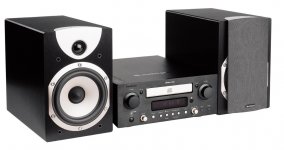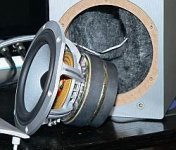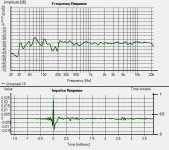I know my chances are less than hitting a state lottery jackpot, but....
I have a pair of those cutie boxes that came with that system, but not hte rest. The problem: tohose boxes work (properly) exclusively with the matching amplifier, since they are response corrected in the low frequencies (Ace Bass system, kind of current feedback system). Without the amp the sound is very thin, not much below 70 Hz (Qts: 0.22, Fs: 75 Hz)
I reworked the woofer (removed the extra magnet, plus softened the suspension) so now they can be used with other amps too. But the crossover now is not matching, and it is potted in an epoxy box, so I can't rework that part. The sound is very good even this way, the Focal Polyglass woofer is a rather decent piece so I'd like to improve on it anyway. Does anyone has any info regarding the crossover of those boxes?
I have a pair of those cutie boxes that came with that system, but not hte rest. The problem: tohose boxes work (properly) exclusively with the matching amplifier, since they are response corrected in the low frequencies (Ace Bass system, kind of current feedback system). Without the amp the sound is very thin, not much below 70 Hz (Qts: 0.22, Fs: 75 Hz)
I reworked the woofer (removed the extra magnet, plus softened the suspension) so now they can be used with other amps too. But the crossover now is not matching, and it is potted in an epoxy box, so I can't rework that part. The sound is very good even this way, the Focal Polyglass woofer is a rather decent piece so I'd like to improve on it anyway. Does anyone has any info regarding the crossover of those boxes?
Attachments
All the AudioPro available schematics showed at HiFiEngine (https://www.hifiengine.com/manual_library/audio-pro.shtml) show the same topology and they change few components from model to model to acomodate different powers and different speakers.
I think you can start there as a reference and then tune the feedback/filter to your modified speakers.
Good luck!
I think you can start there as a reference and then tune the feedback/filter to your modified speakers.
Good luck!
Thanks for your help, but what I need is the crossover schematic [& parts list] of the actual speakers (not for the amplifiers), that are not available on the linked website.... The problem is that the epoxy potted XO network cannot be dismantled without destroying the parts inside.... 😢
Sorry, I do not know the models you showed in the picture.
I think they are new and probably quite different from the old models of the original company.
If you have means to do impedance and acoustic measurements, maybe you can try a high pass filter with variable parameters (Fo, freq. and Q) which will allow you to compensate your modified speakers, although not a feedback system.
I think they are new and probably quite different from the old models of the original company.
If you have means to do impedance and acoustic measurements, maybe you can try a high pass filter with variable parameters (Fo, freq. and Q) which will allow you to compensate your modified speakers, although not a feedback system.
skyra,
contact AudioPro by email. I´ve done that myself concerning an old sub and I got the schematics and suggestions how fix the problem.
contact AudioPro by email. I´ve done that myself concerning an old sub and I got the schematics and suggestions how fix the problem.
Hello
I use a pair of speakers from Audio pro Stereo one Limited. The audio pro amp broke and I got a NAD D3020 v2.
Found that it sounded thin in the bass register. I use amplifier and speakers together with computer at my desk and now use equalizer APO 1.3 (free) to compensate the thin sound. I have used REW room acoustics software(free) + UMIK1($79) and rephase(free) to make a wav file (linear phase) which I run in APO 1.3 to compensate for this. I have not tried to change the construction of the speaker, however this way seems to be enough for me. There are many youtube clips that describe the work process.
My simple measurement in my room shows that the speakers reproduce approximately 20db higher from 110hz to 1300hz compared to the other frequencies. There are also apps for phones to create a wav file that can be saved and for example used with APO 1.3, the phone's microphone does not have a calibration file (like UMIK1) but I have heard that the result is usually good anyway. This may not help you who chose to modify your speaker. I thought I'd share this because I think these speakers sound really good with the measures I described. In addition, the job of learning to use the software is fun and you can tailor the sound to your own taste.
Have Fun!

I use a pair of speakers from Audio pro Stereo one Limited. The audio pro amp broke and I got a NAD D3020 v2.
Found that it sounded thin in the bass register. I use amplifier and speakers together with computer at my desk and now use equalizer APO 1.3 (free) to compensate the thin sound. I have used REW room acoustics software(free) + UMIK1($79) and rephase(free) to make a wav file (linear phase) which I run in APO 1.3 to compensate for this. I have not tried to change the construction of the speaker, however this way seems to be enough for me. There are many youtube clips that describe the work process.
My simple measurement in my room shows that the speakers reproduce approximately 20db higher from 110hz to 1300hz compared to the other frequencies. There are also apps for phones to create a wav file that can be saved and for example used with APO 1.3, the phone's microphone does not have a calibration file (like UMIK1) but I have heard that the result is usually good anyway. This may not help you who chose to modify your speaker. I thought I'd share this because I think these speakers sound really good with the measures I described. In addition, the job of learning to use the software is fun and you can tailor the sound to your own taste.
Have Fun!
Well, this thing became a kind of obsession for me, so -after measuring both drivers without xo- finally I redesigned and rebuilt the crossover. Also to compensate for the low end loss in the response I've built a simple shelving low-pass filter - as on the picture- inserted in front of the power amp. The result is not bad both measurement and listening-wise.... (measured with HolmImpulse from 1m on tweeter axis with 1/6 octave resolution). The suckout at 140-200 Hz is due to floor reflection-cancellation.
Attachments
- Home
- Loudspeakers
- Multi-Way
- Audio Pro Stereo One speaker question



